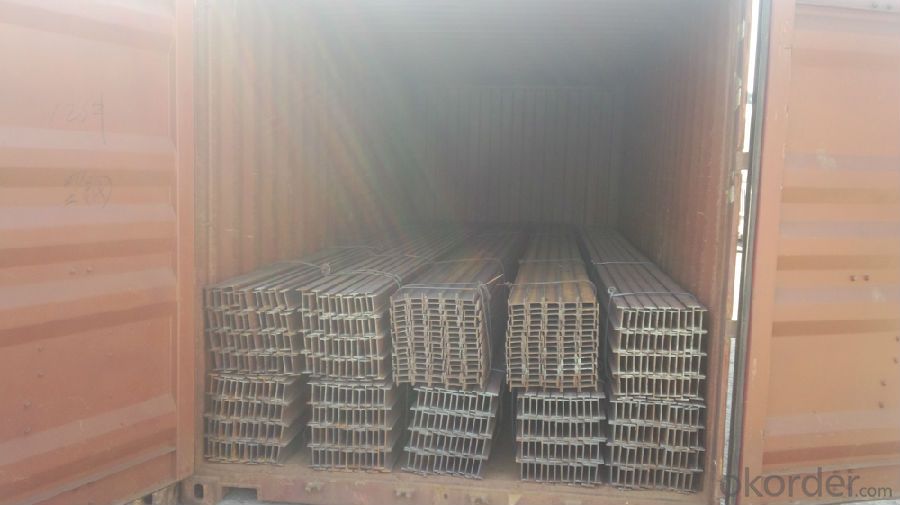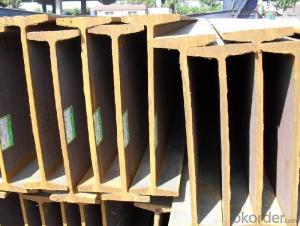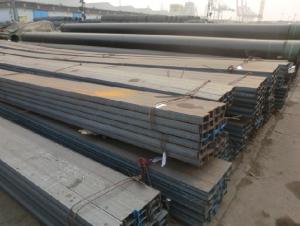Mild Steel I Beams IPE/IPEAA Q235, A36, S235JR
- Loading Port:
- Tianjin
- Payment Terms:
- TT OR LC
- Min Order Qty:
- 25 m.t.
- Supply Capability:
- 200000 m.t./month
OKorder Service Pledge
OKorder Financial Service
You Might Also Like
Item specifice
Product Description:
OKorder is offering Mild Steel I Beams IPE/IPEAA Q235, A36, S235JR at great prices with worldwide shipping. Our supplier is a world-class manufacturer of steel, with our products utilized the world over. OKorder annually supplies products to European, North American and Asian markets. We provide quotations within 24 hours of receiving an inquiry and guarantee competitive prices.
Product Applications:
Mild Steel I Beams IPE/IPEAA Q235, A36, S235JR are widely used in various construction structures, bridges, autos, brackets, mechanisms and so on.
Product Advantages:
OKorder's Mild Steel I Beams IPE/IPEAA Q235, A36, S235JR are durable, strong, and resist corrosion. The goods is produced from the steel billets of high quality. And can be used widely.
Main Product Features:
· Premium quality
· Prompt delivery & seaworthy packing (30 days after receiving deposit)
· Corrosion resistance
· Can be recycled and reused
· Mill test certification
· Professional Service
· Competitive pricing
Product Specifications:
1. Product name: Mild Steel I Beams IPE/IPEAA Q235, A36, S235JR
2. Production Standard: EN10025, GB Standard, ASTM, JIS etc.
3. Steel Grade: Q235B, A36, S235JR, Q345, SS400 or other equivalent.
4. Length: 5.8M, 6M, 9M, 10M, 12M or as your requirements

Section | Standard Sectional Dimensions(mm) | ||||
h | b | s | t | Mass Kg/m | |
IPE80 | 80 | 46 | 3.80 | 5.20 | 6.00 |
IPE100 | 100 | 55 | 4.10 | 5.70 | 8.10 |
IPE120 | 120 | 64 | 4.80 | 6.30 | 10.40 |
IPE140 | 140 | 73 | 4.70 | 6.90 | 12.90 |
IPE160 | 160 | 82 | 5.00 | 7.40 | 15.80 |
IPE180 | 180 | 91 | 5.30 | 8.00 | 18.80 |
IPE200 | 200 | 100 | 5.60 | 8.50 | 22.40 |
IPE220 | 220 | 110 | 5.90 | 9.20 | 26.20 |
IPE240 | 240 | 120 | 6.20 | 9.80 | 30.70 |
IPE270 | 270 | 135 | 6.60 | 10.20 | 36.10 |
IPEAA80 | 80 | 46 | 3.20 | 4.20 | 4.95 |
IPEAA100 | 100 | 55 | 3.60 | 4.50 | 6.72 |
IPEAA120 | 120 | 64 | 3.80 | 4.80 | 8.36 |
IPEAA140 | 140 | 73 | 3.80 | 5.20 | 10.05 |
IPEAA160 | 160 | 82 | 4.00 | 5.60 | 12.31 |
IPEAA180 | 180 | 91 | 4.30 | 6.50 | 15.40 |
IPEAA200 | 200 | 100 | 4.50 | 6.70 | 17.95 |
5.Color marking: There will be color marking on both end of the bundle for the cargo delivered by bulk vessel. That makes it easily to distinguish at the destination port.
Tag mark: there will be tag mark tied up on the bundles. The information usually including supplier logo and name, product name, made in China, shipping marks and other information request by the customer.
If loading by container the marking is not needed, but we will prepare it as customer request.
6. Shipment Items: By containers or by bulk cargo. Depends on customers
FAQ:
Q1: Why buy Mild Steel I Beams IPE/IPEAA Q235, A36, S235JR China from OKorder.com?
A1: All products are carefully selected from China's most reliable manufacturing enterprises. Through its ISO certifications, OKorder.com adheres to the highest standards and a commitment to supply chain safety and customer satisfaction. We can guarantee the quality!
Q2: The products are invoicing on theoretical weight or on actual weight?
A2: We can do it in both manners, it’s according to buyer's requirement.
Q3: Can you offer the third part inspection certificates ?
A3: Yes, we can apply third part inspection before shipping, such as SGS, BV, etc .
Images:


- Q:Can steel I-beams be used in transportation or infrastructure renovation projects?
- Yes, steel I-beams can be used in transportation or infrastructure renovation projects. They are commonly used as structural components in bridges, highways, and buildings due to their high strength and load-bearing capacity. Steel I-beams provide structural stability and durability, making them suitable for various construction and renovation applications in transportation and infrastructure projects.
- Q:What's the difference between plain I-beam and light I-beam? What is light I-beam?
- Ordinary I-beam, light I-beam flange is variable cross-section, depending on the thickness of the web, the external thin; H steel: HW, HM, HN, HEA, HEB, HEM and so on, the flange of I-beam is a uniform section. The material is different.
- Q:What are the different methods of inspecting steel I-beams for defects or damage?
- There are several methods available for inspecting steel I-beams for defects or damage. These include visual inspection, ultrasonic testing, magnetic particle testing, dye penetrant testing, and radiographic testing. Visual inspection involves physically examining the beam for any visible signs of cracks, corrosion, or other abnormalities. Ultrasonic testing uses sound waves to detect internal flaws by measuring the time it takes for the waves to bounce back. Magnetic particle testing and dye penetrant testing are techniques used to identify surface cracks and discontinuities by applying magnetic particles or dye to the surface and observing any indications. Lastly, radiographic testing involves using X-rays or gamma rays to create an image of the beam, allowing for the detection of internal defects or damage.
- Q:I want to use a lever beam point, two meters away from the middle of the fulcrum, to lift two tons half the weight of I-beam with much?
- Generally, stainless steel needs the worst stress, slightly better carbon steel, and low-alloy steel is the best. But in low alloy steels, the steels with higher strength tend to have lower toughness and worse toughness. They require severe deflection and overall instability, but will reduce the load-carrying capacity of the steel, increase the size and waste the material.Generally on the market, the common Q235-B, Q345, more. The parameter you are giving is incomplete. I wonder if you could estimate the coefficient of the lifting dynamic load If the dynamic coefficient of the 1.65 of the general equipment lug is concerned, the overall instability will be a destructive factor. You're more reliable than 20A or 20b i-beam. I think it would be safer to smash 250B I-beam if I often throw it crosswise. But the weight of 2 and a half tons is very low. Not very tall. The steel structures I make often hoist more than 60 tons.
- Q:What are the different fabrication methods for steel I-beams?
- There are several different fabrication methods used for steel I-beams, each with its own advantages and applications. 1. Hot rolling: This is the most common method used to fabricate steel I-beams. In this process, a large steel billet is heated above its recrystallization temperature and then passed through a series of rollers to shape it into the desired I-beam profile. Hot rolling provides excellent structural integrity and produces I-beams with consistent dimensions and mechanical properties. 2. Welding and assembly: Another method involves welding or assembling individual steel plates or sections to create the I-beam shape. This method is often used for custom or specialized applications where the dimensions or properties of the I-beam need to be adjusted. Welding can be done using different techniques such as submerged arc welding or gas metal arc welding, depending on the specific requirements. 3. Cold rolling: In this method, steel strips or plates are passed through a series of rollers at room temperature to gradually shape them into the I-beam profile. Cold rolling is generally used for smaller-sized I-beams or for applications where dimensional accuracy and surface finish are critical. It is also commonly used for stainless steel I-beams. 4. Extrusion: Extrusion is a process used to create complex cross-sectional shapes with a continuous length. In the case of steel I-beams, a heated billet is forced through a die to form the desired I-beam shape. Extrusion is often used for manufacturing lightweight or specialized I-beams with unique profiles. Each fabrication method has its own advantages and considerations, such as cost, production speed, size limitations, and the ability to meet specific design requirements. The choice of fabrication method depends on factors like the desired I-beam size, properties, and application.
- Q:How are steel I-beams protected against vandalism?
- Steel I-beams can be protected against vandalism in several ways. One common method is applying an anti-graffiti coating to the surface of the beams. This coating acts as a barrier, preventing paint, markers, or other graffiti materials from adhering to the surface. If vandalism does occur, the anti-graffiti coating allows for easier removal of the graffiti without damaging the steel underneath. Another method of protection is the use of security cameras or surveillance systems in areas where the I-beams are installed. These cameras can deter potential vandals and provide evidence in case of any vandalism incidents. Additionally, well-lit areas can discourage vandalism as it increases the risk of being caught. In some cases, physical barriers such as fences or barriers can be installed around the steel I-beams to limit access and prevent unauthorized individuals from approaching or tampering with them. This can be particularly effective in outdoor installations or public spaces. Furthermore, regular maintenance and inspections are crucial in identifying and addressing any signs of vandalism. Timely repairs or repainting can help minimize the impact of vandalism and prevent further damage. Overall, a combination of preventative measures, surveillance systems, regular maintenance, and prompt repairs can help protect steel I-beams against vandalism and minimize any potential damage caused by such acts.
- Q:Can steel I-beams be used in water treatment or wastewater facilities?
- Indeed, water treatment or wastewater facilities can make use of steel I-beams. These beams are frequently employed in the construction sector owing to their robustness, long-lasting nature, and capacity to bear heavy loads. Given that water treatment or wastewater facilities necessitate the installation of hefty equipment and machinery, steel I-beams fulfill the essential role of providing structural support. They can be effectively employed to suspend or affix diverse components like pumps, motors, and tanks. Moreover, steel I-beams possess the ability to endure the harsh and corrosive environments typically encountered in water treatment or wastewater facilities, rendering them an ideal choice for such applications.
- Q:What are the potential drawbacks of using steel I-beams?
- There are several potential drawbacks of using steel I-beams in construction projects. Firstly, steel is a heavy material, which means that the overall weight of the structure may increase significantly. This can result in additional costs for transportation and installation, as well as potential limitations in terms of the overall design and load-bearing capacity of the building. Secondly, steel I-beams are susceptible to corrosion if they are not properly protected. Exposure to moisture or harsh environmental conditions can lead to rusting, which weakens the structural integrity of the beams over time. Regular maintenance and protective coatings are necessary to mitigate this issue, which can add to the overall cost and effort required for upkeep. Furthermore, steel I-beams have a high thermal conductivity, meaning they can easily conduct heat or cold. This can lead to energy inefficiency as heat or cold is readily transferred through the beams, necessitating additional insulation measures to maintain comfortable indoor temperatures. These insulation requirements can add to the construction costs and potentially affect the overall energy efficiency of the building. Lastly, steel production has a significant environmental impact. The extraction and processing of raw materials for steel production can contribute to deforestation, habitat destruction, and greenhouse gas emissions. Additionally, the manufacturing process itself consumes vast amounts of energy and generates substantial carbon emissions. Therefore, the use of steel I-beams may not align with sustainable building practices and environmental goals. Overall, while steel I-beams offer excellent strength and durability, the potential drawbacks related to weight, corrosion, thermal conductivity, and environmental impact should be carefully considered before deciding to use them in construction projects.
- Q:How do steel I-beams compare to concrete beams?
- When it comes to structural support in construction projects, both steel I-beams and concrete beams are popular options. Let's compare the two: Strength: Steel I-beams are renowned for their impressive strength-to-weight ratio, making them exceptionally strong and capable of handling heavy loads. On the other hand, concrete beams are also strong but have a lower strength-to-weight ratio. Flexibility: Steel I-beams offer great flexibility, allowing for various design possibilities and the accommodation of different architectural requirements. Concrete beams, while not as flexible, can still be molded into different shapes. Construction time: Steel I-beams are usually quicker to install since they come prefabricated and can be easily bolted or welded together. Conversely, concrete beams require more time for construction as they need to be poured and cured on-site. Cost: Steel I-beams tend to be pricier than concrete beams due to the cost of raw materials and the manufacturing process. Conversely, concrete beams are generally less expensive, particularly when using locally sourced materials. Fire resistance: Steel I-beams possess good fire resistance as they do not burn, but they can lose strength when exposed to high temperatures. In contrast, concrete beams have excellent fire resistance and can withstand high temperatures without significant strength loss. Maintenance: Steel I-beams necessitate regular maintenance to prevent rusting and corrosion, which can affect their structural integrity over time. Concrete beams, on the other hand, require minimal maintenance and are more resistant to environmental factors. Environmental impact: Steel I-beams have a higher carbon footprint due to the energy-intensive production process and the extraction of raw materials. Likewise, concrete beams contribute to carbon emissions during production, but they can be more environmentally friendly when using recycled materials or incorporating supplementary cementitious materials. In conclusion, steel I-beams are stronger, more flexible, and quicker to install, but they are generally more expensive and require more maintenance. Concrete beams are cost-effective, possess excellent fire resistance, and require minimal maintenance, but they have a lower strength-to-weight ratio and take longer to construct. Ultimately, the choice between steel I-beams and concrete beams depends on the specific needs of the construction project.
- Q:How do you reinforce a steel I-beam?
- Different methods can be utilized to reinforce a steel I-beam, depending on the specific circumstances and requirements. Here are a few commonly employed approaches: 1. Welding extra steel plates: One way to reinforce the I-beam is by welding additional steel plates onto its flanges or web. These plates can be strategically placed to enhance the beam's load-carrying capacity and strength. The size and thickness of the plates will depend on the necessary reinforcement. 2. Incorporating steel sections: Another option involves adding supplementary steel sections to the existing I-beam. This can be achieved by welding or bolting them together to form a composite beam. By combining multiple beams, the overall stiffness and strength of the structure can be improved. 3. Implementing external bracing: External bracing can be employed to reinforce the I-beam. This entails attaching braces or cross-members to the beam to provide additional support and prevent buckling or twisting. Bracing can be made from various materials such as steel or concrete, and its design will be tailored to the specific load and structural requirements. 4. Using carbon fiber reinforcement: Carbon fiber materials can be utilized to strengthen steel I-beams. Carbon fiber sheets or strips can be bonded to the beam's surface using epoxy resin. This technique adds strength and stiffness to the beam while also offering corrosion resistance and maintaining a lightweight structure. 5. Employing post-tensioning: Post-tensioning is a technique where high-strength steel tendons or cables are installed within the beam and then tensioned. This process applies compressive forces to the beam, increasing its load-carrying capacity and reducing deflection. Post-tensioning is commonly employed in larger structures and requires specialized expertise. It is important to emphasize that the reinforcement of a steel I-beam should only be carried out by a qualified structural engineer or professional who possesses knowledge of the specific requirements and load conditions. They can evaluate the structural needs, determine the necessary reinforcement, and ensure that the modifications comply with relevant building codes and standards.
1. Manufacturer Overview |
|
|---|---|
| Location | |
| Year Established | |
| Annual Output Value | |
| Main Markets | |
| Company Certifications | |
2. Manufacturer Certificates |
|
|---|---|
| a) Certification Name | |
| Range | |
| Reference | |
| Validity Period | |
3. Manufacturer Capability |
|
|---|---|
| a)Trade Capacity | |
| Nearest Port | |
| Export Percentage | |
| No.of Employees in Trade Department | |
| Language Spoken: | |
| b)Factory Information | |
| Factory Size: | |
| No. of Production Lines | |
| Contract Manufacturing | |
| Product Price Range | |
Send your message to us
Mild Steel I Beams IPE/IPEAA Q235, A36, S235JR
- Loading Port:
- Tianjin
- Payment Terms:
- TT OR LC
- Min Order Qty:
- 25 m.t.
- Supply Capability:
- 200000 m.t./month
OKorder Service Pledge
OKorder Financial Service
Similar products
New products
Hot products
Related keywords





























